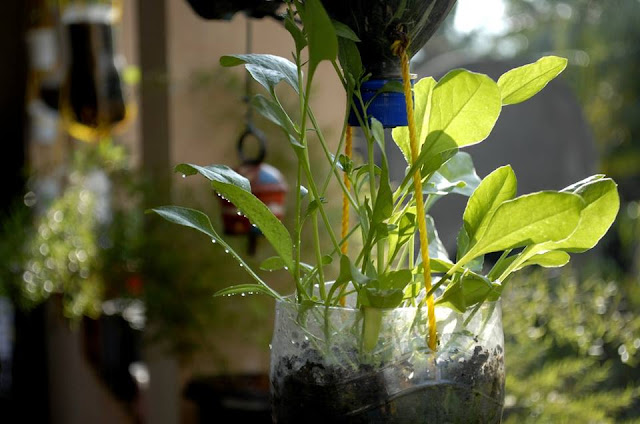Nanna ivattina, swalp kahi... swalp khara... swalp huli... hagalkayi uppinkayi.
And what a beautiful experience it was making this hot and tangy with a bitter undertone, bitter gourd pickle...
I think I have fallen in love , with making pickles...
The recipe:
Ingredients
Bitter gourds: Small tender ones. Half kilo
Red ripe chillies: Twelve
Garlic cloves: Twenty
Curry leaves: Four sprigs. Finely slivered
Oil: About one full cup
Salt: To taste (I add lesser than for usual pickles)
Jaggery: Half teaspoon (Or more of you want to reduce the bitterness even more. I like the bitter undertone of these gourds)
Turmeric: Half teaspoon
Red chilli powder: Half teaspoon (Or more if you want it nice and hot)
Tamarind paste: Two teaspoons
Mustard: Small grain. Two teaspoons
Hing/Asafoeteda: Half teaspoon
Method:
1. Wash the bitter gourds and pat them dry.
2. Chop them into pieces of your choice.
3. Soak the bitter gourd pieces in water with salt and turmeric added to it for about fifteen minutes. Squeeze the pieces of all the water and keep aside.
4. Heat the oil in a pan. Add mustard seeds and let them sputter.
5. Add the garlic, red chillies, curry leaves and asafoetida and stir for a short while. Don't let the garlic or curry leaves turn brown.
6. Add the bitter gourd pieces and saute till a little soft.
7. Now add the turmeric, chilli powder, salt, jaggery and tamarind paste. Stir well and saute till the raw smell of the tamarind pulp is gone.
8. Turn off the heat and let the mixture cool.
9. Store your pickle in an airtight jay/bottle.
This pickle gets a lovely reddish brown hue and a tongue-tickling, hot and tangy with a bitter undertone flavour. You could have it immediately or wait for a couple of days for it to improve. Since you have added enough oil to this pickle, it would not spoil easily and you could store it for quite some time. But then, it turns out so tasty, I doubt you would let it last for long. I started having mine within an hour of making it !
Well, making pickles is turning out to be an undoubtedly beautiful experience and sends me back to those days when Granny used to make pickles of all kinds throughout the year, with seasonal vegetables and fruits. The house used to get filled with the aroma of freshly made pickles and the kitchen loft would be lined with those quintessential white and brown "uppinkayi bharanis". I doubt I can ever match Granny's pickle-making proficiency, but nevertheless, I don't think I am going to stop with just these two pickles. (The previous one being my fresh turmeric and ginger pickle, that I made last week) I might as well take advantage of the pickling-high I am on and try out another pickle...
And what a beautiful experience it was making this hot and tangy with a bitter undertone, bitter gourd pickle...
I think I have fallen in love , with making pickles...
The recipe:
Ingredients
Bitter gourds: Small tender ones. Half kilo
Red ripe chillies: Twelve
Garlic cloves: Twenty
Curry leaves: Four sprigs. Finely slivered
Oil: About one full cup
Salt: To taste (I add lesser than for usual pickles)
Jaggery: Half teaspoon (Or more of you want to reduce the bitterness even more. I like the bitter undertone of these gourds)
Turmeric: Half teaspoon
Red chilli powder: Half teaspoon (Or more if you want it nice and hot)
Tamarind paste: Two teaspoons
Mustard: Small grain. Two teaspoons
Hing/Asafoeteda: Half teaspoon
Method:
1. Wash the bitter gourds and pat them dry.
2. Chop them into pieces of your choice.
3. Soak the bitter gourd pieces in water with salt and turmeric added to it for about fifteen minutes. Squeeze the pieces of all the water and keep aside.
4. Heat the oil in a pan. Add mustard seeds and let them sputter.
5. Add the garlic, red chillies, curry leaves and asafoetida and stir for a short while. Don't let the garlic or curry leaves turn brown.
6. Add the bitter gourd pieces and saute till a little soft.
7. Now add the turmeric, chilli powder, salt, jaggery and tamarind paste. Stir well and saute till the raw smell of the tamarind pulp is gone.
8. Turn off the heat and let the mixture cool.
9. Store your pickle in an airtight jay/bottle.
This pickle gets a lovely reddish brown hue and a tongue-tickling, hot and tangy with a bitter undertone flavour. You could have it immediately or wait for a couple of days for it to improve. Since you have added enough oil to this pickle, it would not spoil easily and you could store it for quite some time. But then, it turns out so tasty, I doubt you would let it last for long. I started having mine within an hour of making it !
Well, making pickles is turning out to be an undoubtedly beautiful experience and sends me back to those days when Granny used to make pickles of all kinds throughout the year, with seasonal vegetables and fruits. The house used to get filled with the aroma of freshly made pickles and the kitchen loft would be lined with those quintessential white and brown "uppinkayi bharanis". I doubt I can ever match Granny's pickle-making proficiency, but nevertheless, I don't think I am going to stop with just these two pickles. (The previous one being my fresh turmeric and ginger pickle, that I made last week) I might as well take advantage of the pickling-high I am on and try out another pickle...





















































